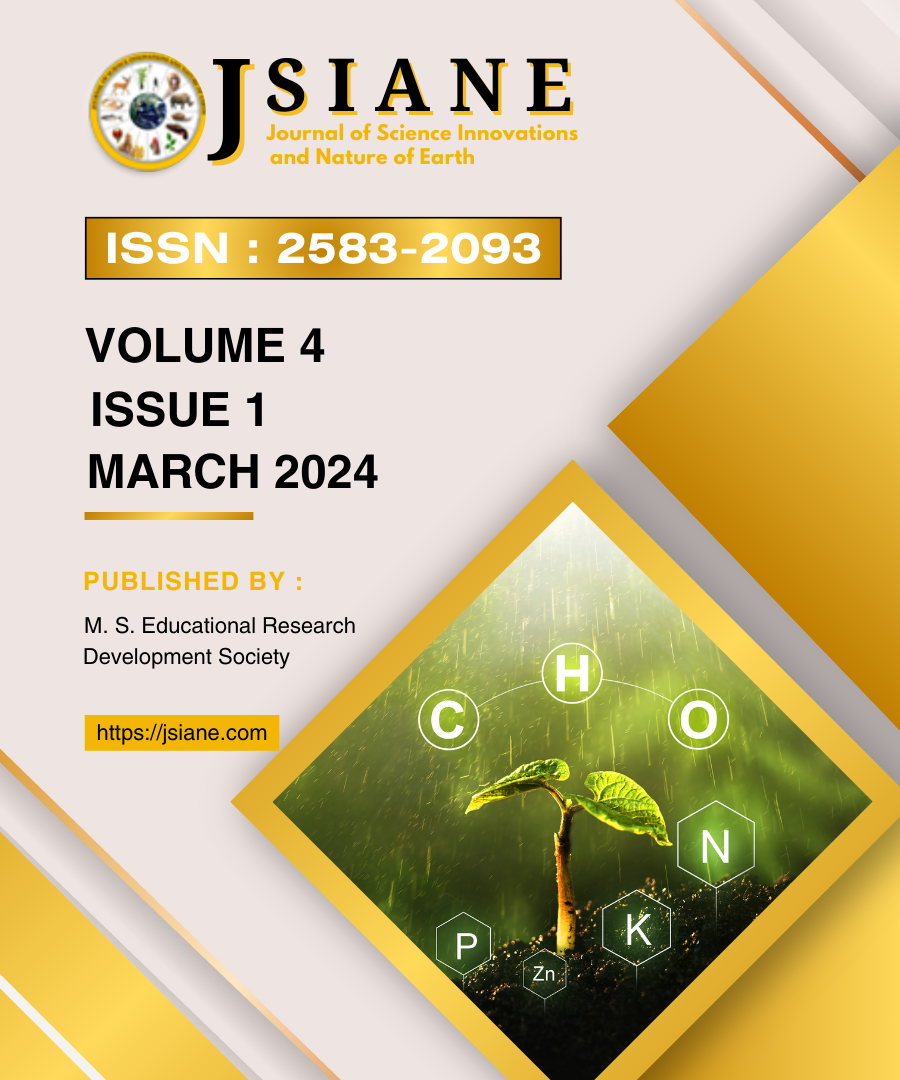SCREENING OF PESTICIDAL PROPERTIES OF LANTANA CAMARA AND CALOTROPIS PROCERA EXTRACT AND ITS APPLICATION AGAINST SPODOPTERA LITURA(TOBACCO CUT-WORM)
DOI:
https://doi.org/10.59436/v4i1/1227Keywords:
Calotropis procera, Lantana camara, Spodoptera litura, mortality, LC50, LC90.Abstract
In recent years botanical extracts that appears to have a vital role in the Development of low cost pesticides together with for Agricultural and forestry crop yield enhancement. Further more for the safety of Environment and public health. The Detrimental Environmental implications of the Synthetic bio-pesticides have forced to search for some substitute methods. This lead to enhanced development of compounds based on the types of naturally occurring toxins of biological origin having a lot of biological activities. This includes plant extracts, which are now well known because they are environmentally harmless and host specific. The different concentrations of plant extracts with different solvents (polar, semi-polar and non-polar) were tested for mortality properties against Spodoptera liturathird instar larvae. The prepared extract of aerial parts of plant Lantana camara and Calotropis procera were tested and the most effective concentrations have been worked out L. camara and C. procera weed plant having different medicinal properties. (MS excel & poloplus) software is applied. The LC50 and LC90 estimated using Hexane, Aqueous, Chloroform, Ethyl acetate, Ethanol extracts of C. proceraand L. camara were 0.24, 0.33, 0.20, 018, 0.15 and 1.97, 3.09, 0.90, 1.77, 0.88 respectively with fiducial limit of 0.16 to 2.44, 0.25 to 10.65, 0.17 to 2.67, 0.15 to 2.00, 0.10 to 5.97 and 0.16 to 2.44, 0.20 to 6.44, 0.17 to 1.61, 0.09 to 6.33, 0.06 to 11.12. The LC50 and LC90 limits estimated with Hexane, Aqueous, Chloroform, Ethyl acetate extract L. camara wire 0.19, 0.26, 0.16, 0.14, 0.13 and 1.35, 3.09, 0.99, 0.79, 0.59. Respectively with fiducial limits of 2.44 to 16.31, 6.44 to 4.98, 1.61 to 9.58, 6.33 to 4.56, 11.12 to 2.33 and 4.08 to 6.17, 10.65 to 5.49, 2.07 to 11.13, 2.00 to 18.96, 5.97 to 6.42 respectively.
References
Ajayi, O.J.T.; Arokoyo, J.T.; Nesan, O.D.; Olaniyan, M.; Ndive Mbula, M. and Kannike, O.A. (1987). Laboratory assessment of the efficacy of some local plant materials for the control of storage insect pests. Samores Journal of Agricultural Research, 5: 81-85.
Begum, N.; Sharma, B.; and Pandey, R.S. (2013). Calotropis proceraand Annona squamosa: potential alternatives to chemical pesticides. Current Journal of Applied Science and Technology Vol.254-267.
Chin, E.I.; Marutescu, L.; M.Popa, S. Cristea (2017). Antimicrobial efficacy of some plants extract on Bacterial ring root pathogen, clavibacter Michiganensis. SSP. Sepidonicus. 79 156-181.
Choi, W.S.; Park, B.S.; Lee, Y.H.; Jang, D.Y.; Yoon, H.Y.; Lee, S.E. (2006). Fumigant Toxicities of essential oils and monotespenes against Lycoriel lamali Adults, crop protection, 398-401.
Gonzalez-Coloma, A. Martm-Benito, D. Mohamed, N. Gascia-vellejo, M.C. Soria, A.C. (2006). Antecedent Effects and Chemical Composition of essential oils from Different populations of Lavander la luisieriL., Biochemical Systematic and Ecology, 34, 609-616.
Ingle, K.P.; Deshmuk, A.G.; Padole, D.A.; Dudhare, M.S.; Moharil M.P.; and V.C. Khelukar, (2017). Bio-efficacy of crude extract from Jatropha curcasAgainst Spodoptera litura. Journal Entomology, Zoology Study, 36-38.
Isikber, A.A.; Alma, M.H.; M.H.M. Kanat, A. Kasci (2006). FumigantToxicity of essential oils from Lauress nobilisand Rosmasinus officinolisagainst all life stages of Tribolium confusum, Phytoporasitica, 34(2); 167-177.
Islam, M.S.; Hasan, M.M.; Xiong, W.; Zhang, S.C.; C.L. Lei (2009). Fumigant and repellent activitiesof essential oil from Coriandrum sativum(Apiaceae) against red flour beetle Tribolum Castaneum(Herbst) (Coleoptera : Tenebrio ridae), Journal of Pest Science, 82: 171-177.
Kebede, Y.; Gebre-Michael, T.; Bolkeo, M.; (2010). Laboratory and field evolutionof neem (Azadirachta indcia A. Juss) and Ghinaberry (Melia Azadirachta L.) oils as repellent against phlebotamus orienritalis and P. bergeroti (Diptera : psychodidae) in Ethopia, Acta, Tropia, 113: 145-150.
Klianzada, S.K.; Shaikh, W.; Kazi, T.G.; Sofia, S.; Kabir, A.; Usmanghani, K.; and Kandhro, A.A. (2008). Analysis of fatty acid elemental and total protein of Calotropis proceramedicinal plant from Sindh, Pakistan, Pakistan Journal Botany, 40(5) : 1913-1921.
Lajide, L.C.O.; Adedire, C.O.; Muse, W.A. andAegle, S.O. (1998). Insecticidal activity of powders of some Nigerian plants against the maize weevil, sitophilus zeamais Motsch in : Entomology and the Nigerian Economy : Research Focus in the 21stCentury; (Lale, NES; Moeta, N.B.; Donli, P.O.; Dike, M.C. and Aminu-Kano, M. Maichiguri eds), Nigeria : Entomological Society of Nigeria (ESN) 227-235. ESN Occasional Publication 31.
Minelli, E.V. and Rebeiro, M.L. (1996). DDT adn HCH residues in blood serum of Malaria control sprayer, Bull. Environmental Containment and Toxicology, 57: 691-696.
Oraon Priti Kumari and Thakur Anand Kumar (2022). Effects of Toxic weed Lantana camara on the feeding behaviour and insecticidal activity of Spodoptera liturafab. (Lapidoptera : Noctuidae). J. Zool. invest. 8(1) : 441-446, 2022.
Pavela, M.; Sajfrtova, H.; Sovova, M.; Barnet, J. Karban (2016). The insecticidal activity of Tanacetum partheniumSchultz-Bip, extracts btained by supercritical fluid extraction and hydrodistillation, Industrial Crops and Products, 449-454.
Qusiw, Huanas, LIC, Chen. S., Peng Z. (2010). Biological activates of the essential oil from the leaves of piper sormenlorum Roxb. and in Chemical Constitute Journal of pest Science 83
Saxena, R.C.; Dixit, O.P.; and Harshan, V. (1992). Insecticidal action of Lantana camara against Callosobruchus chinensis(Coleoptera: Bruchidae), Journal of Stored Product Research, 28(4): 279-281.
Subramanyam, B. and Roeseli, R. (2000). An alternative to pesticides in stored products IPM 321-380,
Springer Boston, M.R.Tang, G.W.; Yang, C.J.; Xie, L.D. (2007). Extraction of Trigonellafoenum-graecumL. by supercritical fluid CO2and its contact toxicity to Rhyzoperthadominica (fabricus) (Coloeoptera Bostrichidae). Journal Pest Science, 80: 151-157.T
schocke, P.H.; Olivior, E.E.; Dalcin, M.S.; Silivera-TS Choclke, M.C.A.; Sormento, R.A. and Santos, G.R. (2019) (2HIQ). Botanical and synthetic pesticides alter the flower visitation rates of pollinator bees in Neotropical Melon fields. Environmental Pollution, 251: 591-599.
Waliszewski, S.M.; Aguirre, A.A.; Benitez, A.; Infanzon, R.M.; Infanzon, R. and Rivera (1999). Organochlorine pesticide residues in human blood serum of inhabitants of Veracruz, Mexico. Bulletin of Environmental Contamination and Toxicology, 62(4): 397-402
Downloads
Published
Issue
Section
License

This work is licensed under a Creative Commons Attribution-NonCommercial 4.0 International License.










